Abstract
The growing "epidemic" of non-valvular atrial fibrillation (NVAF) with its associated morbidity and mortality intersects with a number of conditions including aging, thromboembolism, stroke, congestive heart failure, hypertension, and perhaps the metabolic syndrome and inflammation.In the USA approximately 2.3 million people currently have NVAF and estimates based upon the United States census and the aging of the population suggests that this will be 3.3 million by 2020 and 5.6 million by 2050. This may be a serious underestimate since recent data from Rochester, Minnesota have demonstrated an almost threefold increase in the prevalence over the last three decades after adjustment for age. The explanation is probably multifactorial but the socioeconomic implications of this phenomenon are enormous and sobering.Ongoing efforts towards understanding atrial fibrillation are driven, in part, by the concept that atrial fibrillation may in most patients be the consequence of a systemic condition, in which reduced vascular compliance, atherosclerosis, obesity, and inflammation are primary causal factors. These epidemiological investigations need to be carried out in association with studies aimed at defining the molecular genetics of atrial fibrillation which hopefully will provide more insights into the structural and electrical phenotypes resulting from genetic mutations and their interactions with the environment.
Full text
PDF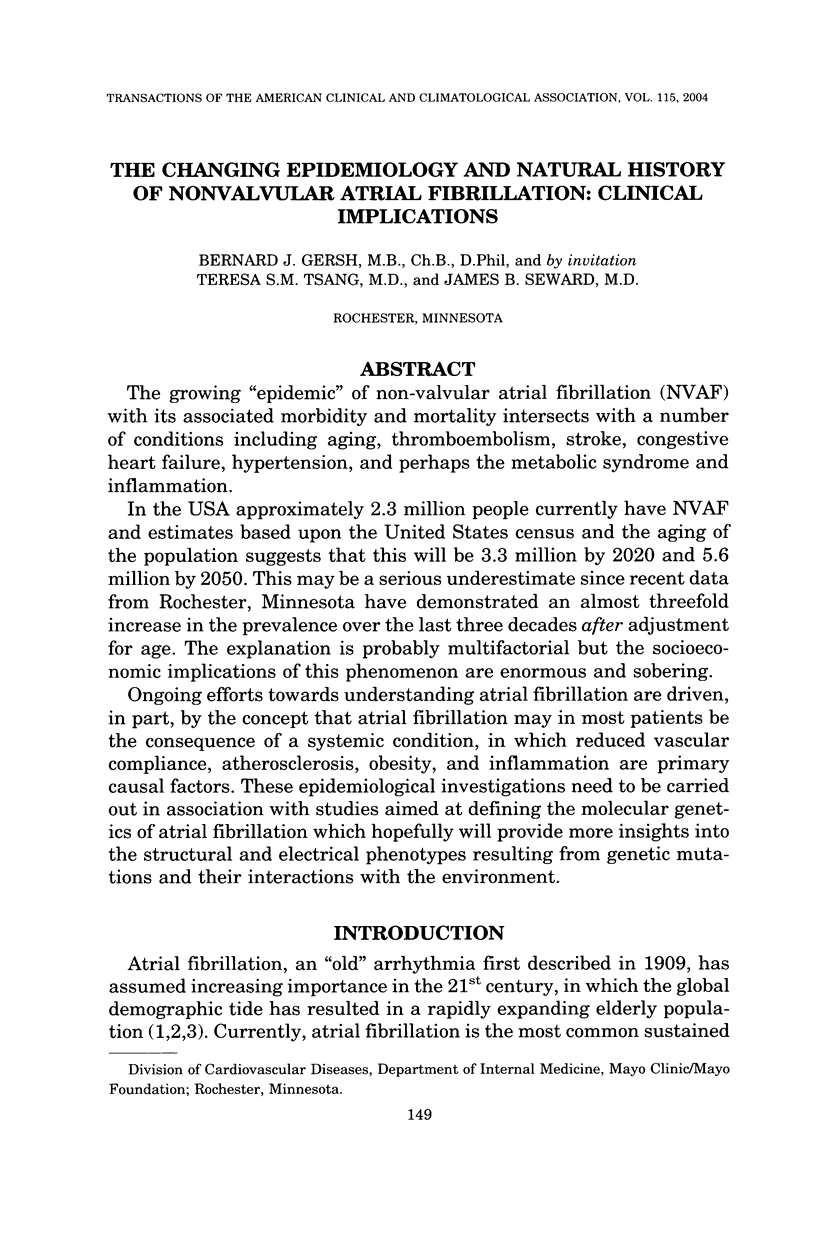
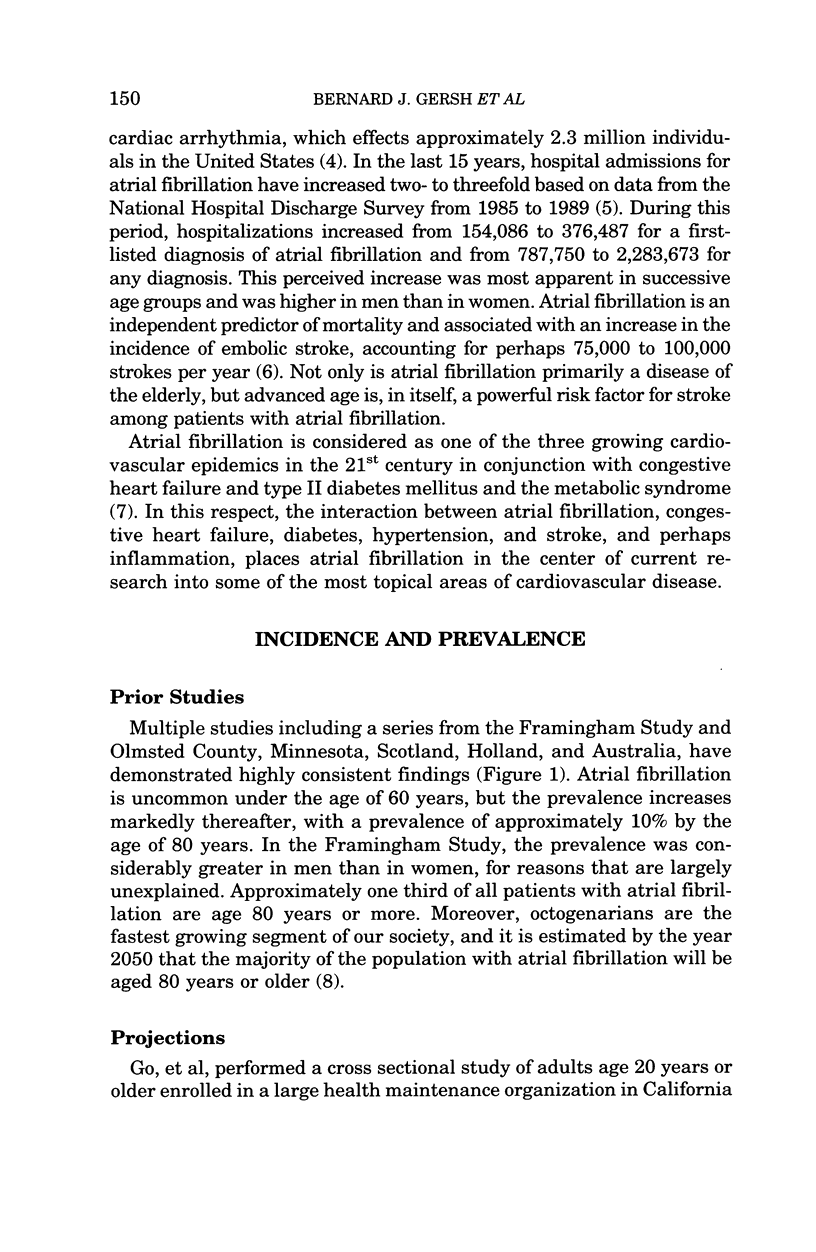

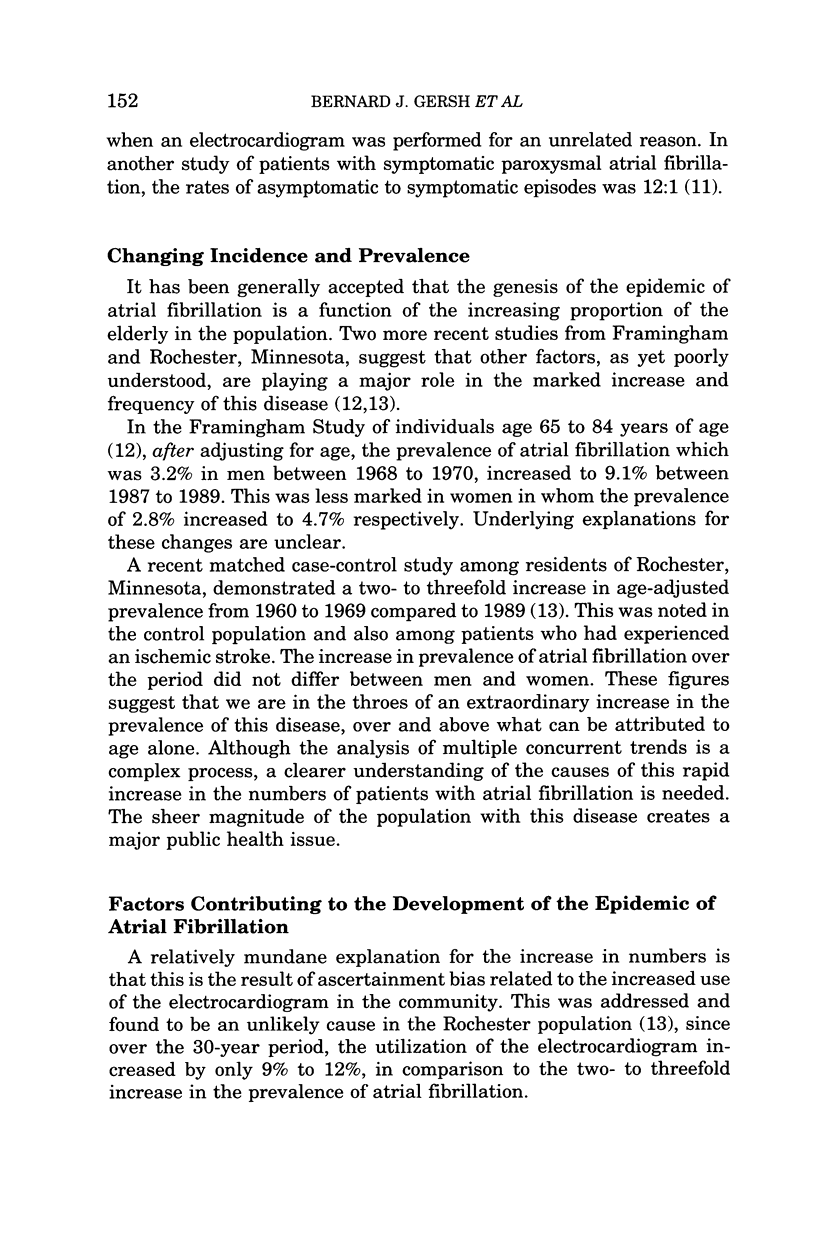
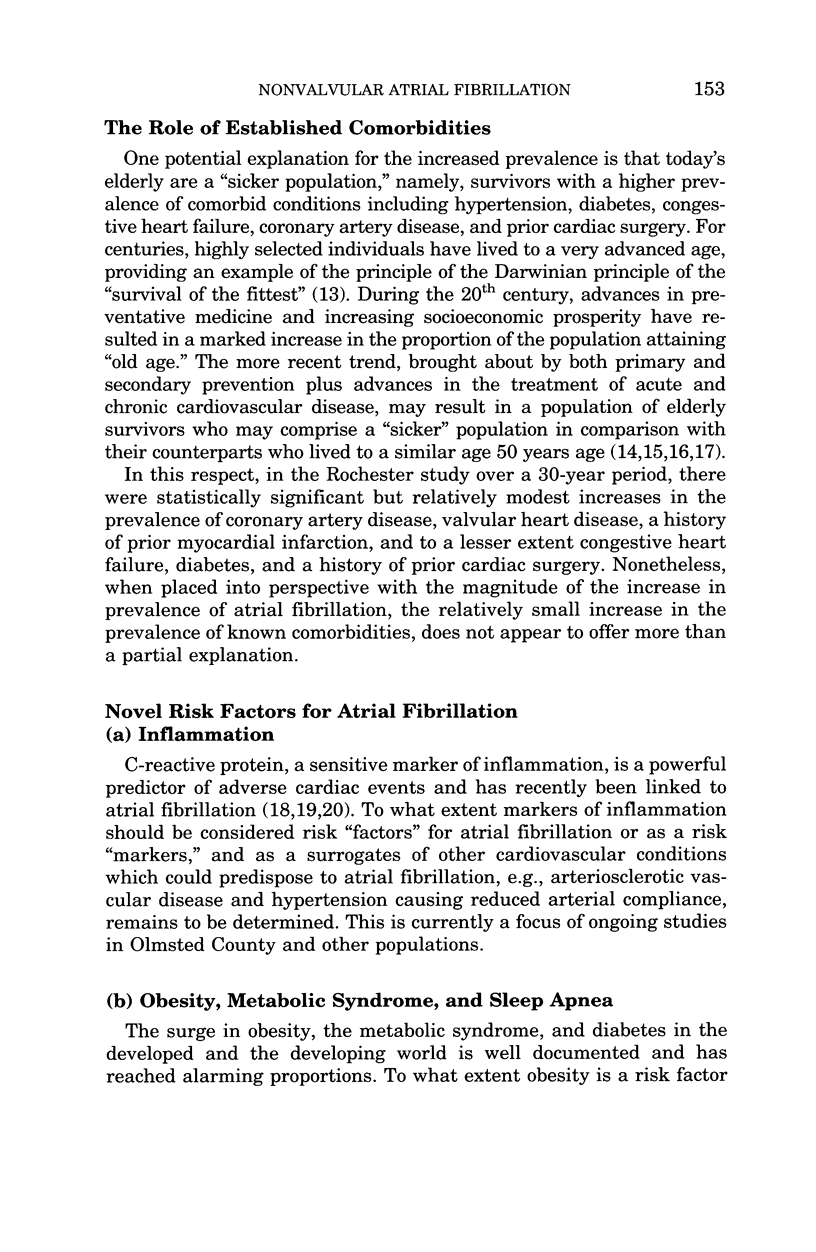
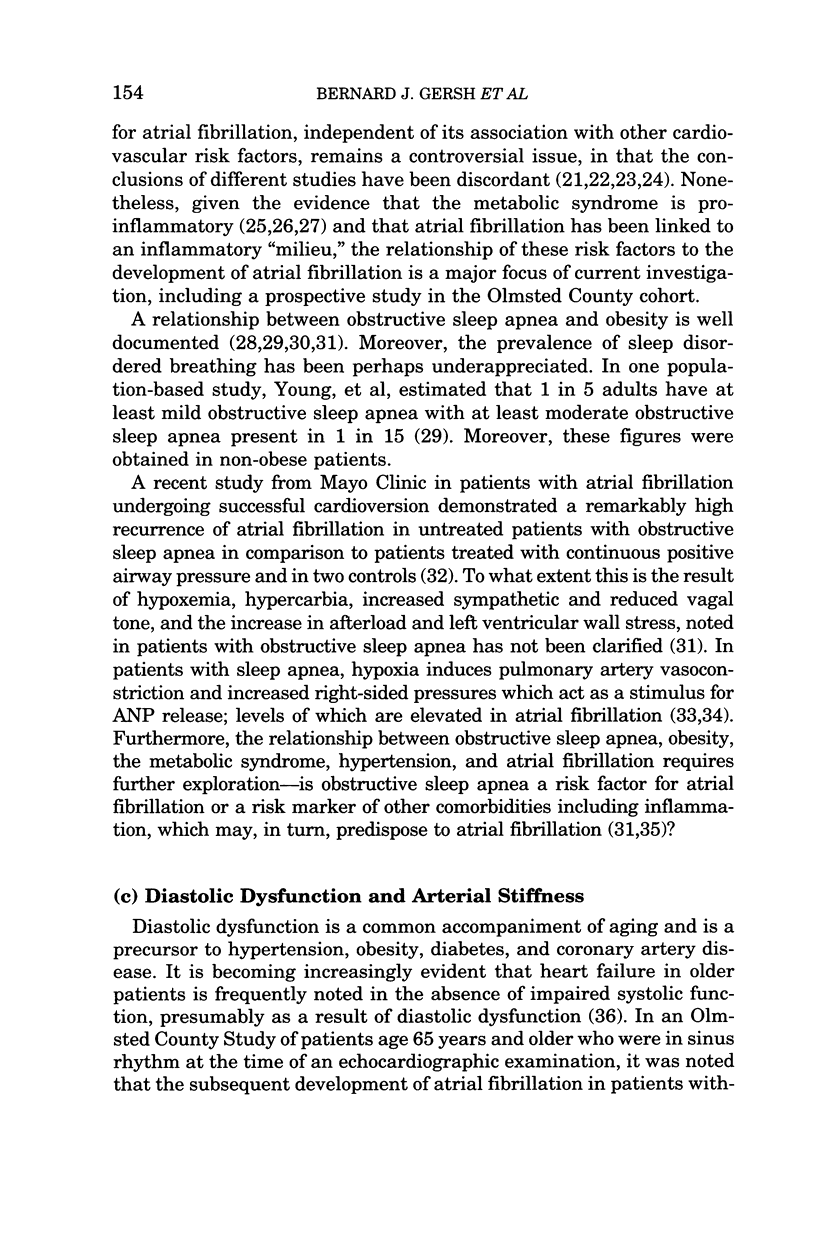
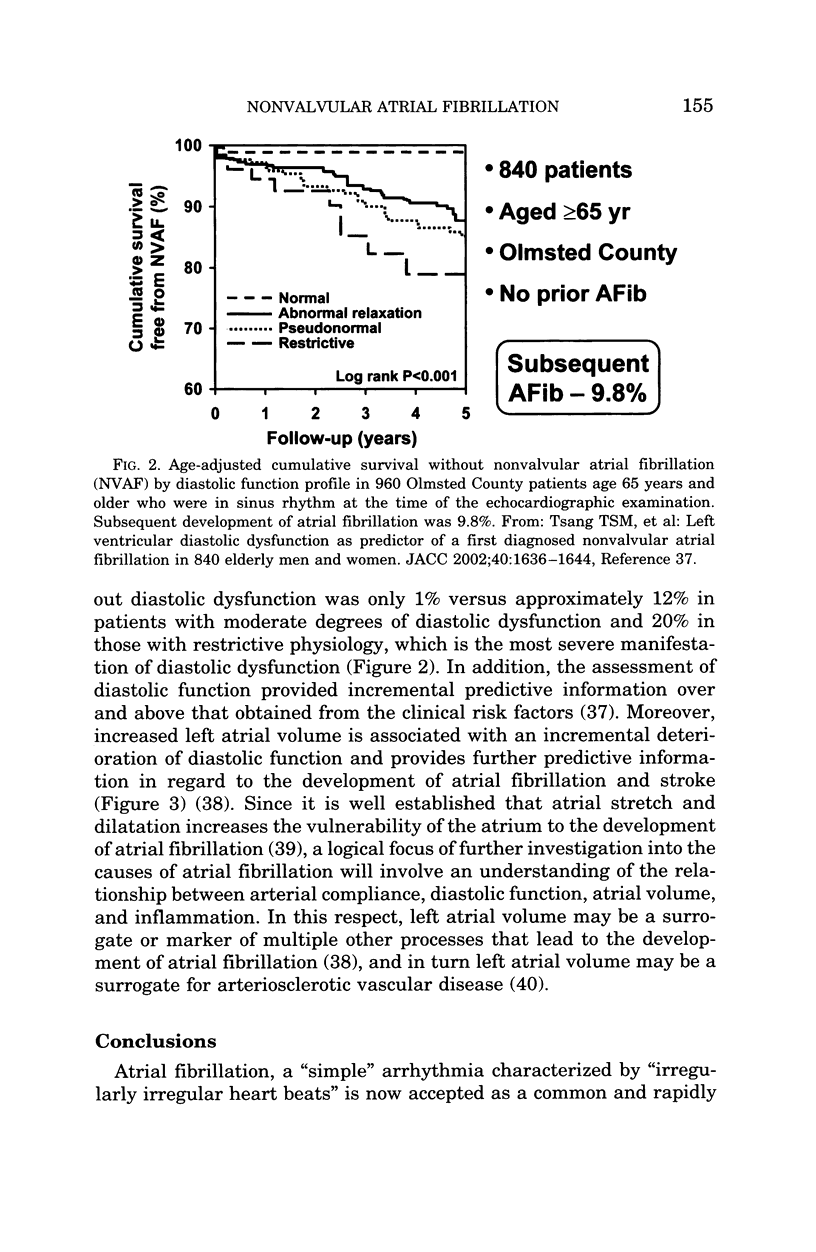
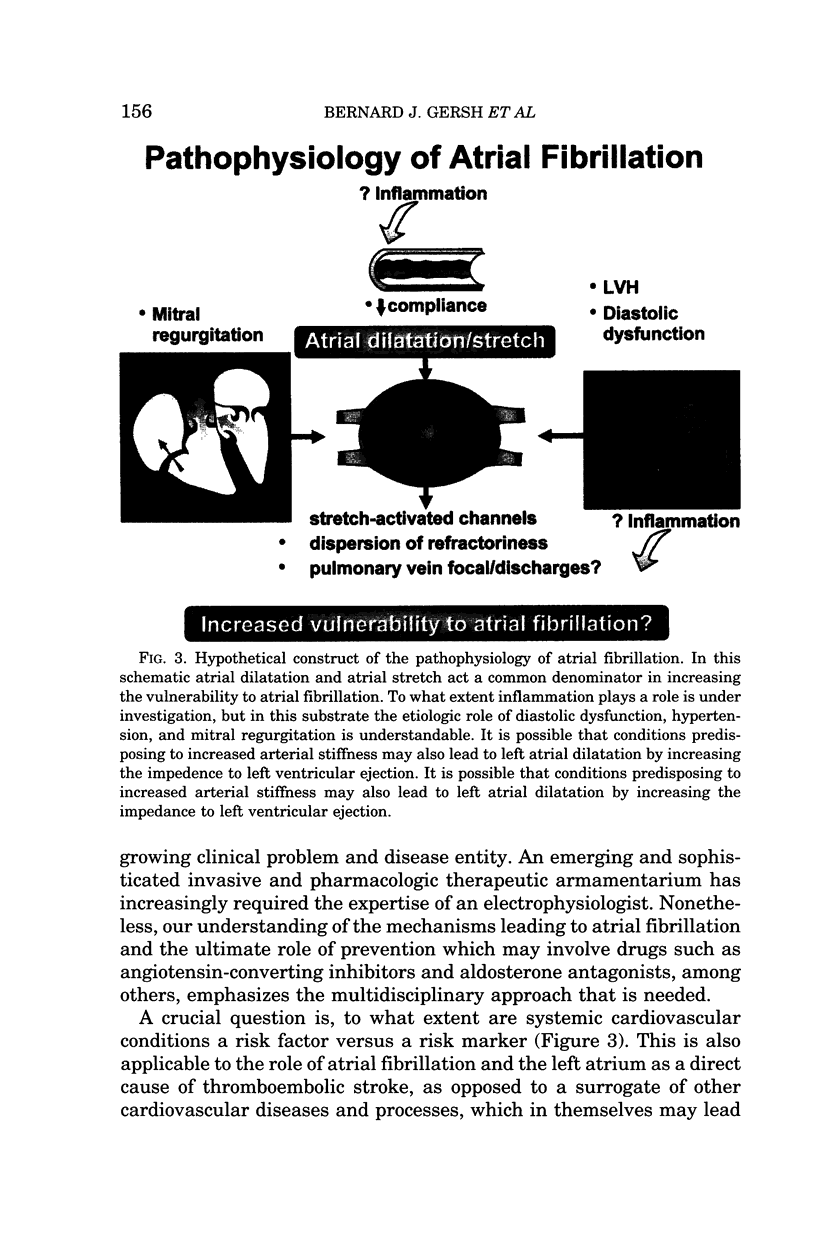
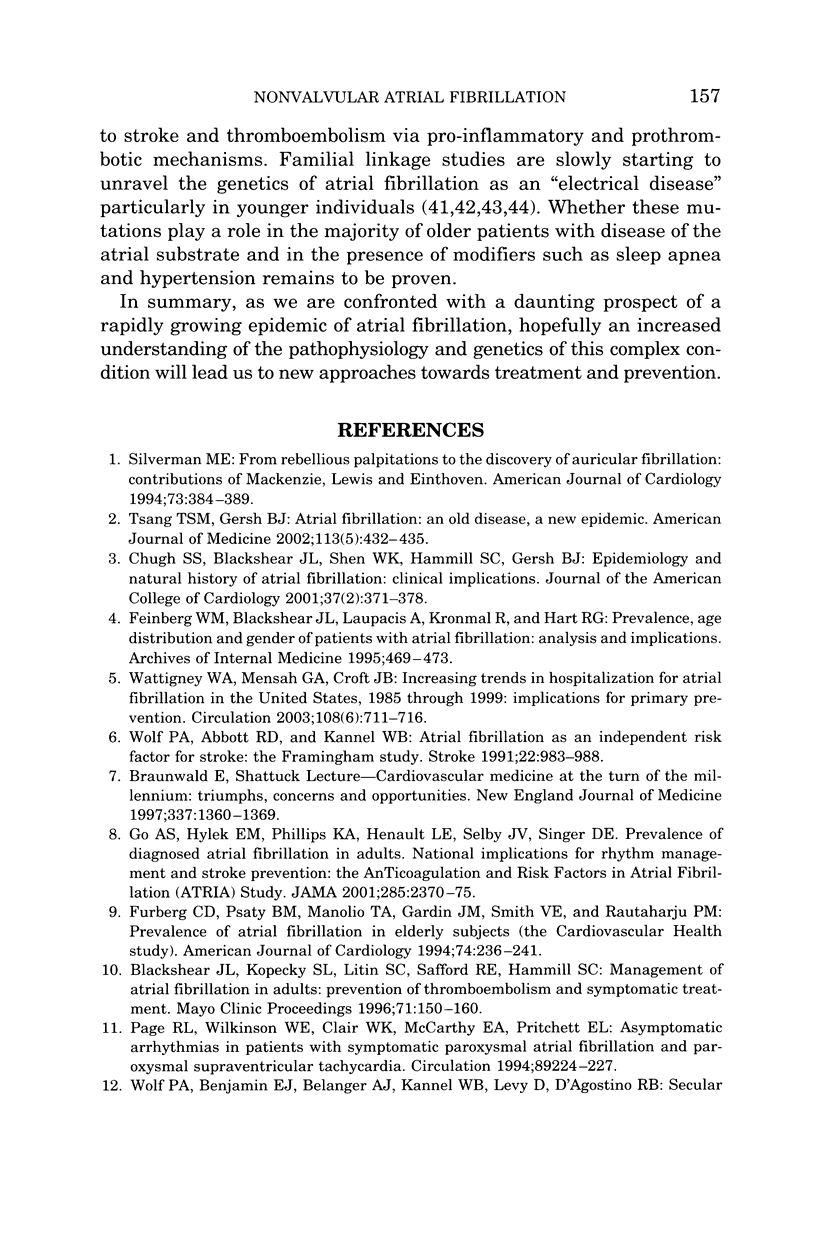
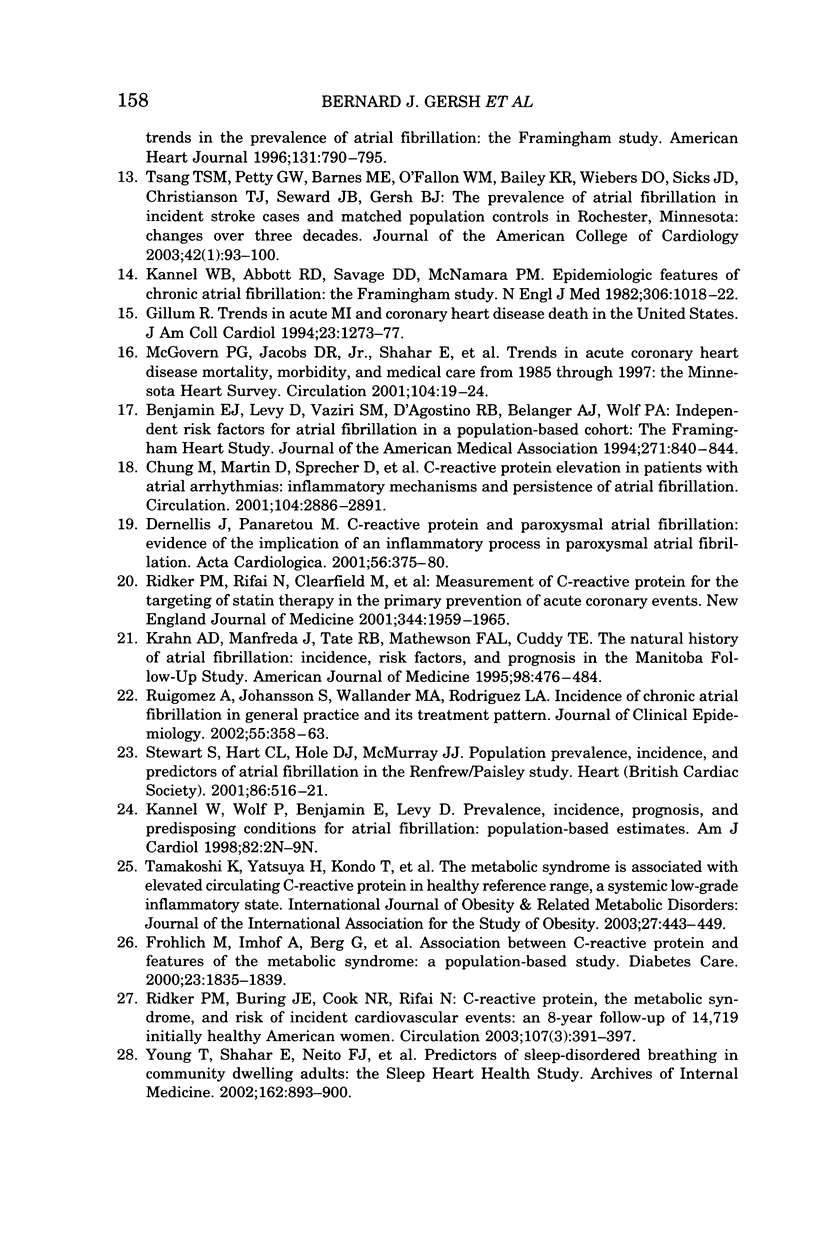
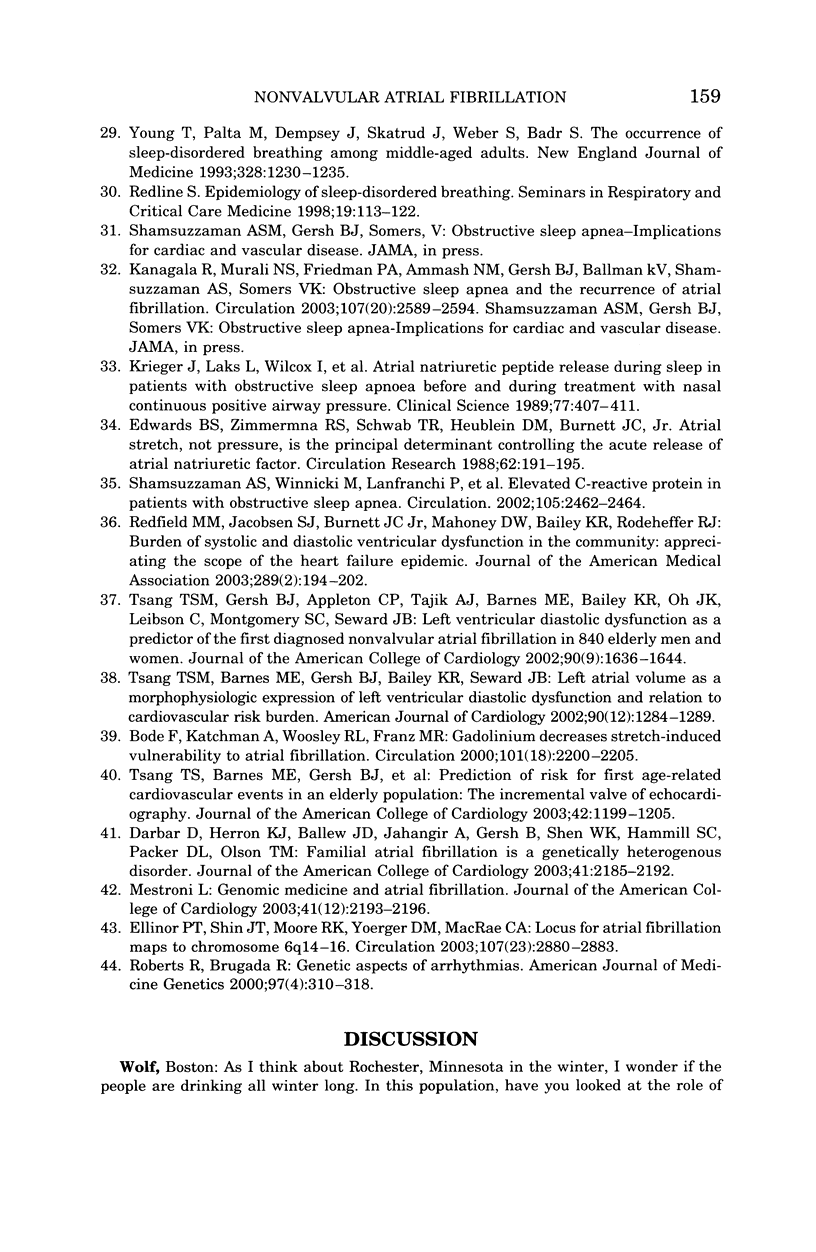
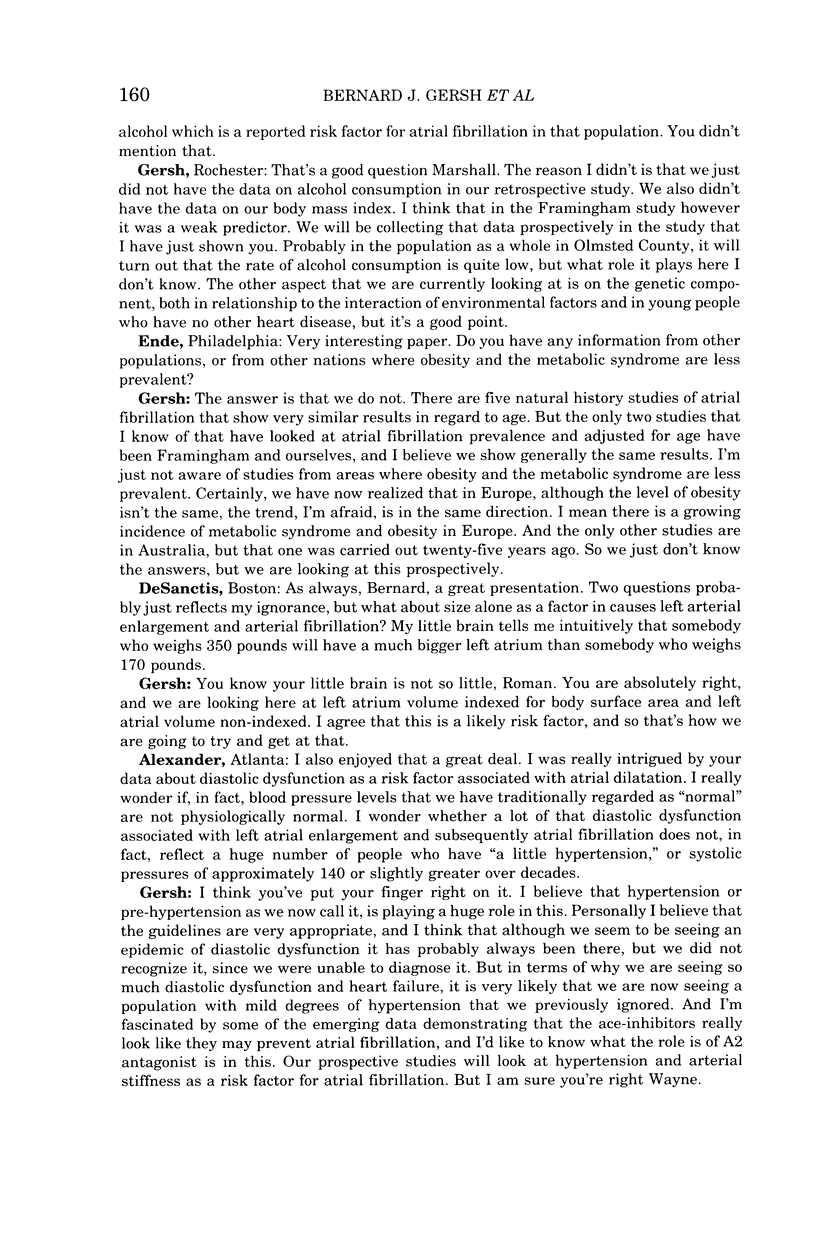
Images in this article
Selected References
These references are in PubMed. This may not be the complete list of references from this article.
- Benjamin E. J., Levy D., Vaziri S. M., D'Agostino R. B., Belanger A. J., Wolf P. A. Independent risk factors for atrial fibrillation in a population-based cohort. The Framingham Heart Study. JAMA. 1994 Mar 16;271(11):840–844. [PubMed] [Google Scholar]
- Blackshear J. L., Kopecky S. L., Litin S. C., Safford R. E., Hammill S. C. Management of atrial fibrillation in adults: prevention of thromboembolism and symptomatic treatment. Mayo Clin Proc. 1996 Feb;71(2):150–160. doi: 10.4065/71.2.150. [DOI] [PubMed] [Google Scholar]
- Bode F., Katchman A., Woosley R. L., Franz M. R. Gadolinium decreases stretch-induced vulnerability to atrial fibrillation. Circulation. 2000 May 9;101(18):2200–2205. doi: 10.1161/01.cir.101.18.2200. [DOI] [PubMed] [Google Scholar]
- Braunwald E. Shattuck lecture--cardiovascular medicine at the turn of the millennium: triumphs, concerns, and opportunities. N Engl J Med. 1997 Nov 6;337(19):1360–1369. doi: 10.1056/NEJM199711063371906. [DOI] [PubMed] [Google Scholar]
- Chugh S. S., Blackshear J. L., Shen W. K., Hammill S. C., Gersh B. J. Epidemiology and natural history of atrial fibrillation: clinical implications. J Am Coll Cardiol. 2001 Feb;37(2):371–378. doi: 10.1016/s0735-1097(00)01107-4. [DOI] [PubMed] [Google Scholar]
- Chung M. K., Martin D. O., Sprecher D., Wazni O., Kanderian A., Carnes C. A., Bauer J. A., Tchou P. J., Niebauer M. J., Natale A. C-reactive protein elevation in patients with atrial arrhythmias: inflammatory mechanisms and persistence of atrial fibrillation. Circulation. 2001 Dec 11;104(24):2886–2891. doi: 10.1161/hc4901.101760. [DOI] [PubMed] [Google Scholar]
- Darbar Dawood, Herron Kathleen J., Ballew Jeffrey D., Jahangir Arshad, Gersh Bernard J., Shen Win-K, Hammill Stephen C., Packer Douglas L., Olson Timothy M. Familial atrial fibrillation is a genetically heterogeneous disorder. J Am Coll Cardiol. 2003 Jun 18;41(12):2185–2192. doi: 10.1016/s0735-1097(03)00465-0. [DOI] [PubMed] [Google Scholar]
- Dernellis J., Panaretou M. C-reactive protein and paroxysmal atrial fibrillation: evidence of the implication of an inflammatory process in paroxysmal atrial fibrillation. Acta Cardiol. 2001 Dec;56(6):375–380. doi: 10.2143/AC.56.6.2005701. [DOI] [PubMed] [Google Scholar]
- Edwards B. S., Zimmerman R. S., Schwab T. R., Heublein D. M., Burnett J. C., Jr Atrial stretch, not pressure, is the principal determinant controlling the acute release of atrial natriuretic factor. Circ Res. 1988 Feb;62(2):191–195. doi: 10.1161/01.res.62.2.191. [DOI] [PubMed] [Google Scholar]
- Ellinor Patrick T., Shin Jordan T., Moore Rachel K., Yoerger Danita M., MacRae Calum A. Locus for atrial fibrillation maps to chromosome 6q14-16. Circulation. 2003 Jun 2;107(23):2880–2883. doi: 10.1161/01.CIR.0000077910.80718.49. [DOI] [PubMed] [Google Scholar]
- Feinberg W. M., Blackshear J. L., Laupacis A., Kronmal R., Hart R. G. Prevalence, age distribution, and gender of patients with atrial fibrillation. Analysis and implications. Arch Intern Med. 1995 Mar 13;155(5):469–473. [PubMed] [Google Scholar]
- Fröhlich M., Imhof A., Berg G., Hutchinson W. L., Pepys M. B., Boeing H., Muche R., Brenner H., Koenig W. Association between C-reactive protein and features of the metabolic syndrome: a population-based study. Diabetes Care. 2000 Dec;23(12):1835–1839. doi: 10.2337/diacare.23.12.1835. [DOI] [PubMed] [Google Scholar]
- Furberg C. D., Psaty B. M., Manolio T. A., Gardin J. M., Smith V. E., Rautaharju P. M. Prevalence of atrial fibrillation in elderly subjects (the Cardiovascular Health Study). Am J Cardiol. 1994 Aug 1;74(3):236–241. doi: 10.1016/0002-9149(94)90363-8. [DOI] [PubMed] [Google Scholar]
- Gillum R. F. Trends in acute myocardial infarction and coronary heart disease death in the United States. J Am Coll Cardiol. 1994 May;23(6):1273–1277. doi: 10.1016/0735-1097(94)90367-0. [DOI] [PubMed] [Google Scholar]
- Go A. S., Hylek E. M., Phillips K. A., Chang Y., Henault L. E., Selby J. V., Singer D. E. Prevalence of diagnosed atrial fibrillation in adults: national implications for rhythm management and stroke prevention: the AnTicoagulation and Risk Factors in Atrial Fibrillation (ATRIA) Study. JAMA. 2001 May 9;285(18):2370–2375. doi: 10.1001/jama.285.18.2370. [DOI] [PubMed] [Google Scholar]
- Kanagala Ravi, Murali Narayana S., Friedman Paul A., Ammash Naser M., Gersh Bernard J., Ballman Karla V., Shamsuzzaman Abu S. M., Somers Virend K. Obstructive sleep apnea and the recurrence of atrial fibrillation. Circulation. 2003 May 12;107(20):2589–2594. doi: 10.1161/01.CIR.0000068337.25994.21. [DOI] [PubMed] [Google Scholar]
- Kannel W. B., Abbott R. D., Savage D. D., McNamara P. M. Epidemiologic features of chronic atrial fibrillation: the Framingham study. N Engl J Med. 1982 Apr 29;306(17):1018–1022. doi: 10.1056/NEJM198204293061703. [DOI] [PubMed] [Google Scholar]
- Krahn A. D., Manfreda J., Tate R. B., Mathewson F. A., Cuddy T. E. The natural history of atrial fibrillation: incidence, risk factors, and prognosis in the Manitoba Follow-Up Study. Am J Med. 1995 May;98(5):476–484. doi: 10.1016/S0002-9343(99)80348-9. [DOI] [PubMed] [Google Scholar]
- Krieger J., Laks L., Wilcox I., Grunstein R. R., Costas L. J., McDougall J. G., Sullivan C. E. Atrial natriuretic peptide release during sleep in patients with obstructive sleep apnoea before and during treatment with nasal continuous positive airway pressure. Clin Sci (Lond) 1989 Oct;77(4):407–411. doi: 10.1042/cs0770407. [DOI] [PubMed] [Google Scholar]
- McGovern P. G., Jacobs D. R., Jr, Shahar E., Arnett D. K., Folsom A. R., Blackburn H., Luepker R. V. Trends in acute coronary heart disease mortality, morbidity, and medical care from 1985 through 1997: the Minnesota heart survey. Circulation. 2001 Jul 3;104(1):19–24. doi: 10.1161/01.cir.104.1.19. [DOI] [PubMed] [Google Scholar]
- Mestroni Luisa. Genomic medicine and atrial fibrillation. J Am Coll Cardiol. 2003 Jun 18;41(12):2193–2196. doi: 10.1016/s0735-1097(03)00459-5. [DOI] [PubMed] [Google Scholar]
- Page R. L., Wilkinson W. E., Clair W. K., McCarthy E. A., Pritchett E. L. Asymptomatic arrhythmias in patients with symptomatic paroxysmal atrial fibrillation and paroxysmal supraventricular tachycardia. Circulation. 1994 Jan;89(1):224–227. doi: 10.1161/01.cir.89.1.224. [DOI] [PubMed] [Google Scholar]
- Redfield Margaret M., Jacobsen Steven J., Burnett John C., Jr, Mahoney Douglas W., Bailey Kent R., Rodeheffer Richard J. Burden of systolic and diastolic ventricular dysfunction in the community: appreciating the scope of the heart failure epidemic. JAMA. 2003 Jan 8;289(2):194–202. doi: 10.1001/jama.289.2.194. [DOI] [PubMed] [Google Scholar]
- Ridker P. M., Rifai N., Clearfield M., Downs J. R., Weis S. E., Miles J. S., Gotto A. M., Jr, Air Force/Texas Coronary Atherosclerosis Prevention Study Investigators Measurement of C-reactive protein for the targeting of statin therapy in the primary prevention of acute coronary events. N Engl J Med. 2001 Jun 28;344(26):1959–1965. doi: 10.1056/NEJM200106283442601. [DOI] [PubMed] [Google Scholar]
- Ridker Paul M., Buring Julie E., Cook Nancy R., Rifai Nader. C-reactive protein, the metabolic syndrome, and risk of incident cardiovascular events: an 8-year follow-up of 14 719 initially healthy American women. Circulation. 2003 Jan 28;107(3):391–397. doi: 10.1161/01.cir.0000055014.62083.05. [DOI] [PubMed] [Google Scholar]
- Roberts R., Brugada R. Genetic aspects of arrhythmias. Am J Med Genet. 2000 Winter;97(4):310–318. doi: 10.1002/1096-8628(200024)97:4<310::aid-ajmg1282>3.0.co;2-7. [DOI] [PubMed] [Google Scholar]
- Ruigómez Ana, Johansson Saga, Wallander Mari Ann, Rodríguez Luis Alberto García. Incidence of chronic atrial fibrillation in general practice and its treatment pattern. J Clin Epidemiol. 2002 Apr;55(4):358–363. doi: 10.1016/s0895-4356(01)00478-4. [DOI] [PubMed] [Google Scholar]
- Shamsuzzaman Abu S. M., Winnicki Mikolaj, Lanfranchi Paola, Wolk Robert, Kara Tomas, Accurso Valentina, Somers Virend K. Elevated C-reactive protein in patients with obstructive sleep apnea. Circulation. 2002 May 28;105(21):2462–2464. doi: 10.1161/01.cir.0000018948.95175.03. [DOI] [PubMed] [Google Scholar]
- Silverman M. E. From rebellious palpitations to the discovery of auricular fibrillation: contributions of Mackenzie, Lewis and Einthoven. Am J Cardiol. 1994 Feb 15;73(5):384–389. doi: 10.1016/0002-9149(94)90013-2. [DOI] [PubMed] [Google Scholar]
- Stewart S., Hart C. L., Hole D. J., McMurray J. J. Population prevalence, incidence, and predictors of atrial fibrillation in the Renfrew/Paisley study. Heart. 2001 Nov;86(5):516–521. doi: 10.1136/heart.86.5.516. [DOI] [PMC free article] [PubMed] [Google Scholar]
- Tamakoshi K., Yatsuya H., Kondo T., Hori Y., Ishikawa M., Zhang H., Murata C., Otsuka R., Zhu S., Toyoshima H. The metabolic syndrome is associated with elevated circulating C-reactive protein in healthy reference range, a systemic low-grade inflammatory state. Int J Obes Relat Metab Disord. 2003 Apr;27(4):443–449. doi: 10.1038/sj.ijo.0802260. [DOI] [PubMed] [Google Scholar]
- Tsang Teresa S. M., Barnes Marion E., Gersh Bernard J., Bailey Kent R., Seward James B. Left atrial volume as a morphophysiologic expression of left ventricular diastolic dysfunction and relation to cardiovascular risk burden. Am J Cardiol. 2002 Dec 15;90(12):1284–1289. doi: 10.1016/s0002-9149(02)02864-3. [DOI] [PubMed] [Google Scholar]
- Tsang Teresa S. M., Barnes Marion E., Gersh Bernard J., Takemoto Yasuhiko, Rosales A. Gabriela, Bailey Kent R., Seward James B. Prediction of risk for first age-related cardiovascular events in an elderly population: the incremental value of echocardiography. J Am Coll Cardiol. 2003 Oct 1;42(7):1199–1205. doi: 10.1016/s0735-1097(03)00943-4. [DOI] [PubMed] [Google Scholar]
- Tsang Teresa S. M., Gersh Bernard J., Appleton Christopher P., Tajik A. Jamil, Barnes Marion E., Bailey Kent R., Oh Jae K., Leibson Cynthia, Montgomery Samantha C., Seward James B. Left ventricular diastolic dysfunction as a predictor of the first diagnosed nonvalvular atrial fibrillation in 840 elderly men and women. J Am Coll Cardiol. 2002 Nov 6;40(9):1636–1644. doi: 10.1016/s0735-1097(02)02373-2. [DOI] [PubMed] [Google Scholar]
- Tsang Teresa S. M., Gersh Bernard J. Atrial fibrillation: an old disease, a new epidemic. Am J Med. 2002 Oct 1;113(5):432–435. doi: 10.1016/s0002-9343(02)01245-7. [DOI] [PubMed] [Google Scholar]
- Tsang Teresa S. M., Petty George W., Barnes Marion E., O'Fallon W. Michael, Bailey Kent R., Wiebers David O., Sicks JoRean D., Christianson Teresa J. H., Seward James B., Gersh Bernard J. The prevalence of atrial fibrillation in incident stroke cases and matched population controls in Rochester, Minnesota: changes over three decades. J Am Coll Cardiol. 2003 Jul 2;42(1):93–100. doi: 10.1016/s0735-1097(03)00500-x. [DOI] [PubMed] [Google Scholar]
- Wattigney Wendy A., Mensah George A., Croft Janet B. Increasing trends in hospitalization for atrial fibrillation in the United States, 1985 through 1999: implications for primary prevention. Circulation. 2003 Jul 28;108(6):711–716. doi: 10.1161/01.CIR.0000083722.42033.0A. [DOI] [PubMed] [Google Scholar]
- Wolf P. A., Abbott R. D., Kannel W. B. Atrial fibrillation as an independent risk factor for stroke: the Framingham Study. Stroke. 1991 Aug;22(8):983–988. doi: 10.1161/01.str.22.8.983. [DOI] [PubMed] [Google Scholar]
- Wolf P. A., Benjamin E. J., Belanger A. J., Kannel W. B., Levy D., D'Agostino R. B. Secular trends in the prevalence of atrial fibrillation: The Framingham Study. Am Heart J. 1996 Apr;131(4):790–795. doi: 10.1016/s0002-8703(96)90288-4. [DOI] [PubMed] [Google Scholar]
- Young T., Palta M., Dempsey J., Skatrud J., Weber S., Badr S. The occurrence of sleep-disordered breathing among middle-aged adults. N Engl J Med. 1993 Apr 29;328(17):1230–1235. doi: 10.1056/NEJM199304293281704. [DOI] [PubMed] [Google Scholar]
- Young Terry, Shahar Eyal, Nieto F. Javier, Redline Susan, Newman Anne B., Gottlieb Daniel J., Walsleben Joyce A., Finn Laurel, Enright Paul, Samet Jonathan M. Predictors of sleep-disordered breathing in community-dwelling adults: the Sleep Heart Health Study. Arch Intern Med. 2002 Apr 22;162(8):893–900. doi: 10.1001/archinte.162.8.893. [DOI] [PubMed] [Google Scholar]



